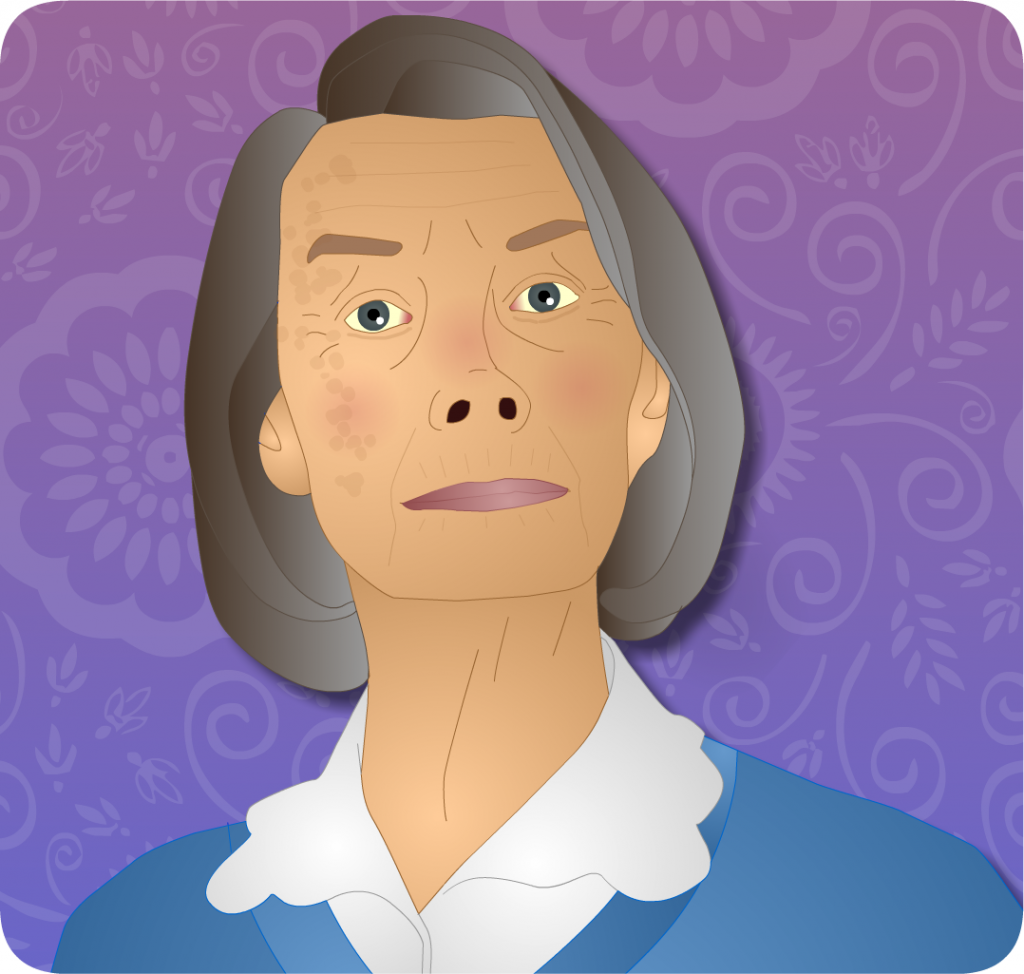The adaptive or functional approach uses repetition of specific functional tasks to learn how to compensate for impairments in daily living activities. It assumes improved performance despite the ongoing existence of a perceptual/cognitive deficit. Interventions include modification of the task or environment; provision of targeted verbal, visual or physical cues or prompts; grading of the task requirements and repetitive practice of a meaningful goal.
The restorative or remedial approach aims to restore impaired skills by practicing specific perceptual functions, e.g. using puzzles or table top tasks. It is anticipated that these improved perceptual skills will then aid more independent functioning. The restorative or remedial approach is thought to be less effective in cognitive or perceptual retraining than an adaptive or functional approach.
What treatment will help Pamela to achieve her goals?
 Nursing staff assisted Pamela to dress herself after they observed her sitting looking blankly at her clothes. When asked, she knew what she was supposed to do, but it was not until she was handed her clothing that she started to put her clothes on. She continued to have difficulty and displayed a tendency to feel for her clothing with her hands.
Nursing staff assisted Pamela to dress herself after they observed her sitting looking blankly at her clothes. When asked, she knew what she was supposed to do, but it was not until she was handed her clothing that she started to put her clothes on. She continued to have difficulty and displayed a tendency to feel for her clothing with her hands.
Recognising agnosia as a possibility, the occupational therapist set up a test:
- Placing a comb, scissors, pencil, key and fork in front of her, she asked Pamela to name each one. Pamela was unable to name or describe the objects.
- When asked to draw each one, Pamela did not recognise the pencil until it was put into her hand and was unable to produce recognisable sketches.
The occupational therapist concluded that Pamela has an apperceptive visual agnosia as she was unable to perceive the shape and structures of the objects presented to her visually, but recognised them when she held them in her hands.
What is visual agnosia?
Visual agnosia is the inability to recognise familiar objects by sight in the absence of any significant visual or intellectual impairment.
There are two types of visual agnosia:
- Apperceptive visual agnosia is characterised by difficulty in forming stable perceptual representations of objects. Recognition issues are based on impairment of visual perception. People with apperceptive visual agnosia may not be able to match or copy shapes or objects but may be able to identify objects from tactile or auditory input.
- Associative (semantic) visual agnosia is characterised by the inability to recognise familiar objects when perception is intact. People with associative agnosia may be able to copy and draw shapes and objects. they may be able to form a mental representation but be unable to associate it with stored knowledge of objects and their use.
The Occupational Therapist carries out a visual screen which includes ocular history, visual fields, neglect/inattention. You can see examples of visual screening tools here.
The occupational therapist also carries out a perceptual screen which is complemented by a functional assessment. Assessment of perceptual skills can be carried out by observing a person’s interaction with objects and their environment or through standardised testing. See Additional Information Box for examples of standardised assessments.
The following table describes the behavioural presentation which may be seen with specific perceptual problems.
| Behavioural presentation which may be seen with specific perceptual problems |
| Form constancy |
Figure-ground discrimination |
Colour discrimination |
| Difficulty recognising objects when presented in altered planes. May not recognise a plate when stacked sideways in the cupboard, or a folded shirt. |
Difficulty distinguishing items from the background. May struggle to identify a fork in a cutlery drawer or an item of clothing in a cluttered drawer. |
Difficulty identifying objects by colour. May have difficulty identifying a specific brand of food which is associated with a certain colour, or sorting out copper and silver coins. |
| Depth/distance discrimination |
Body scheme |
Spatial relations |
| Difficulty judging depth and distance. May over or under pour liquid into a cup or need to feel the depth of a stair tread to climb them. |
Difficult relating the position of body parts to each other. May confuse right and left sides of body whilst dressing or appear to be clumsy. |
Difficulty judging distance and relating the position of objects to each other and to oneself. May have difficulty fitting a lid on a teapot or reaching for a cup which is positioned behind another object |
Watch these video clips to see some common visual problems:
Results of screen: Pamela is demonstrating problems with visual discrimination, specifically with form constancy and figure ground discrimination. The Occupational Therapist recognises that Pamela still has problems with usual forms of the object and questions if she has visual agnosia.
Pamela continues to have problems, however, the signs and symptoms of delirium and hallucinations have subsided. It remained uncertain as to the cause of the hallucinations.
After spending 10 days in the acute stroke unit Pamela is transferred to the stroke rehabilitation unit for ongoing assessment of her continued problems.

The team note that Pamela is disorientated, agitated, becomes distracted when completing activities and is becoming upset that she can’t find her cat. She appears to be reaching out for something and is brushing imaginary items away.
The doctors question delirium and hallucinations and begin their investigations.
Note: It can be challenging to determine whether Pamela’s presentation and hallucinations are related to delirium, or whether her hallucinations are directly related to the stroke. The following pages provide information on delirium and hallucinations.


Pamela is a 72-year old woman who is a retired legal secretary. She lives with her husband Derek in their own home. They have a cat. Pamela and Derek both enjoyed an active lifestyle including lawn bowls and going on holiday, especially cruises. They have a daughter and son who both live away from home.
Pamela wakes and her husband Derek notices that she is confused and agitated and has some weakness in her left arm. He calls the NHS 24 111 service, who send an ambulance as they suspect it may be a stroke. She has a CT scan which shows an infarct in the right parieto-occipital area. Thrombolysis cannot be administered as the time of onset of her stroke cannot be established.
She is admitted to the acute stroke unit and is assessed by the multidisciplinary team.
 Nursing staff assisted Pamela to dress herself after they observed her sitting looking blankly at her clothes. When asked, she knew what she was supposed to do, but it was not until she was handed her clothing that she started to put her clothes on. She continued to have difficulty and displayed a tendency to feel for her clothing with her hands.
Nursing staff assisted Pamela to dress herself after they observed her sitting looking blankly at her clothes. When asked, she knew what she was supposed to do, but it was not until she was handed her clothing that she started to put her clothes on. She continued to have difficulty and displayed a tendency to feel for her clothing with her hands.



